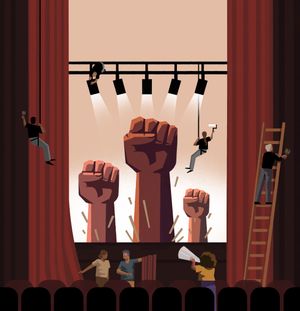Seattle theater leaders work toward anti-racism
December 19, 2020 at 6:00 am | Updated December 21, 2020 at 9:45 am

(Jennifer Luxton / The Seattle Times)
By
Seattle Times features reporter
In late May, just a few days after the killing of George Floyd, a group of Seattle theater leaders met on Zoom to talk about what they should do.
This was not remarkable. As the summer protest movement gathered steam, leaders of companies and nonprofits across the U.S. — Nike, TikTok, Doctors Without Borders, L’Oréal — were meeting, scrambling to put out solidarity statements and rethink marketing campaigns.
But the Seattle theater leaders were starting something different, something much more ambitious, though they didn’t fully realize it yet. They were beginning a process to overhaul the entire ecology of their field, at every level — casting, staffing, fundraising, boards, tech crews, audiences, everything — and inject anti-racism into its DNA.
Slowly, others around the country are starting to hear about the Seattle effort, now officially calling itself Seattle Theatre Leaders (STL), and watch its progress. If STL succeeds, if this broad coalition of theater makers effectively transforms one part of the arts world in one city, it might just set a standard that can be exported — not simply to other arts disciplines, but to other sectors in America that are struggling with the deep, pervasive and seemingly intractable problem of institutional racism.
“It’s really exciting what’s coming out of and through Seattle — I don’t think there’s another city doing this,” said Nicole Brewer, a faculty member at Yale School of Drama who is in very high demand these days as an anti-racist consultant across the English-speaking world, including a recent job at Shakespeare’s Globe theater in London. (In previous years, Brewer gave about one training a month. Since June, she’s given 56 — sometimes to as many as 400 people — including a few with STL this fall.)
“This could be transferred to other industries,” she said. “It’s really exciting what’s coming out of and through Seattle as a model not just for others around the country, but around the world.”
Since May, two main tactics have guided STL’s efforts.
First: Build a broad coalition. Over 80 leaders (mostly artistic directors) representing almost 50 organizations are involved, from the city’s behemoths to its tadpoles, in a list of theaters that aren’t usually mentioned in the same breath: ACT Theatre, The 5th Avenue Theatre, eSe Teatro, Café Nordo, Seattle Repertory Theatre, The Hansberry Project, Intiman Theatre, On the Boards, Village Theatre, Brown Soul Productions, Taproot Theatre, Jet City Improv, dozens more.
Remarkably, STL members say, this coalition has flattened and democratized the usual arts-nonprofit pecking order. When it comes to anti-racism work, the largest theaters have no more clout than the smallest — a bigger budget doesn’t equal a bigger megaphone.
Second: Virtuous-sounding solidarity statements are OK, but they’re not nearly enough. STL is after concrete action and is currently drawing up a list of action items and commitments written by and for local theater makers.
The list is still being written and STL as a group declined to share a current draft. But individual members talked about the kinds of proposals being discussed: a binding code of community conduct; the creation and funding of a neutral body to adjudicate any grievances; larger organizations leveraging their connections with foundations to help smaller organizations find grant money; fast-track leadership pipelines for artists of color; establishing regional standards for anti-racist training.
Some of the proposals are more specific, addressing problems individual members brought to the larger group.
For example: Theater artist Kathy Hsieh (co-director of SIS Productions, as well as the head of cultural partnerships and grants for Seattle’s Office of Arts & Culture) brought up the phenomenon of white directors asking actors of color to do free dramaturgical and research work. It’s not uncommon, she said, for actors like her to land roles across the Asian spectrum — Japanese, Chinese, Korean — and be expected to serve as unpaid experts on all things Asian.
